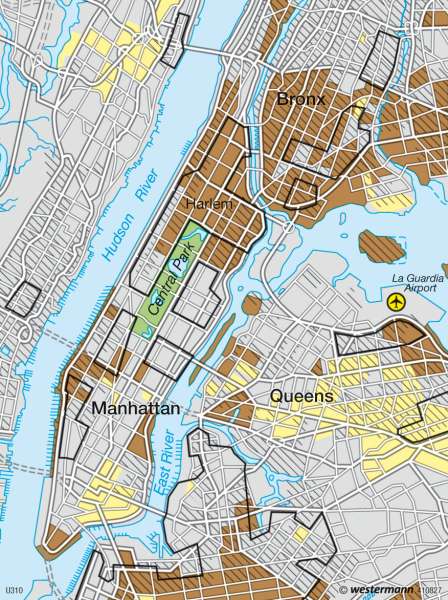New York — Ethnic residential areas
U.S.A. - Cities in the North-East
978-3-14-100790-9 | Page 143 | Ill. 3

Information
The City of New York with 8.2 million inhabitants has a larger population than Switzerland and twice as many inhabitants as the Republic of Ireland. Its urban area of 1,214 km² is only slightly larger than Hamburg and Cologne together (755 and 405 km²). Roughly two thirds of the land area (786 km²) and residual water areas (429 km²) result in an average population density of almost 10,500 inhabitants per square kilometre. The city and district boundaries have changed little since 1898.Facts and Figures
New York is divided into five districts (boroughs). The largest in terms of population is Brooklyn with 2.5 million inhabitants to 251 km² (of which 68 km² is water), followed by Queens with 2.2 million inhabitants to 462 km² (of which 179 km² is water), Manhattan with 1.6 million inhabitants to 87 km² (of which 28 km² is water), the Bronx with 1.4 million inhabitants on 149 km² (of which 40 km² is water) and finally, Staten Island with 500,000 inhabitants to 265 km² (of which 114 km² is water). The Bronx is on the mainland while all other districts are either independent islands, such as Manhattan and Staten Island, or are located on Long Island like Brooklyn and Queens. The districts are linked by numerous bridges, tunnels and ferries.
New York is unique for its immigrants and their characteristic diversities. Within the city boundaries these diversities have, to some extent, formed a spatially separated urban concentration of the ethnic and immigrant groups. The African-American and Hispanic population reside primarily in the Bronx, Harlem and Brooklyn, but Queens is particularly the main district for Hispanics communities. The Asian population is concentrated in Chinatown, Queens and in the northern suburbs on the New Jersey side.
With changes in the number and origin of immigrants, this spatial structure is subjected to constant change. For example, Chinatown expanded with approximately 80,000 Chinese residents in the 1980's from Canal Street out into the adjacent region of Little Italy. At present, the rising numbers of immigrants come primarily from Latin America and Eastern Europe (Poland, CIS).
M. Felsch, R. Köhler; Ü: C. Fleming




